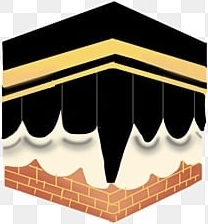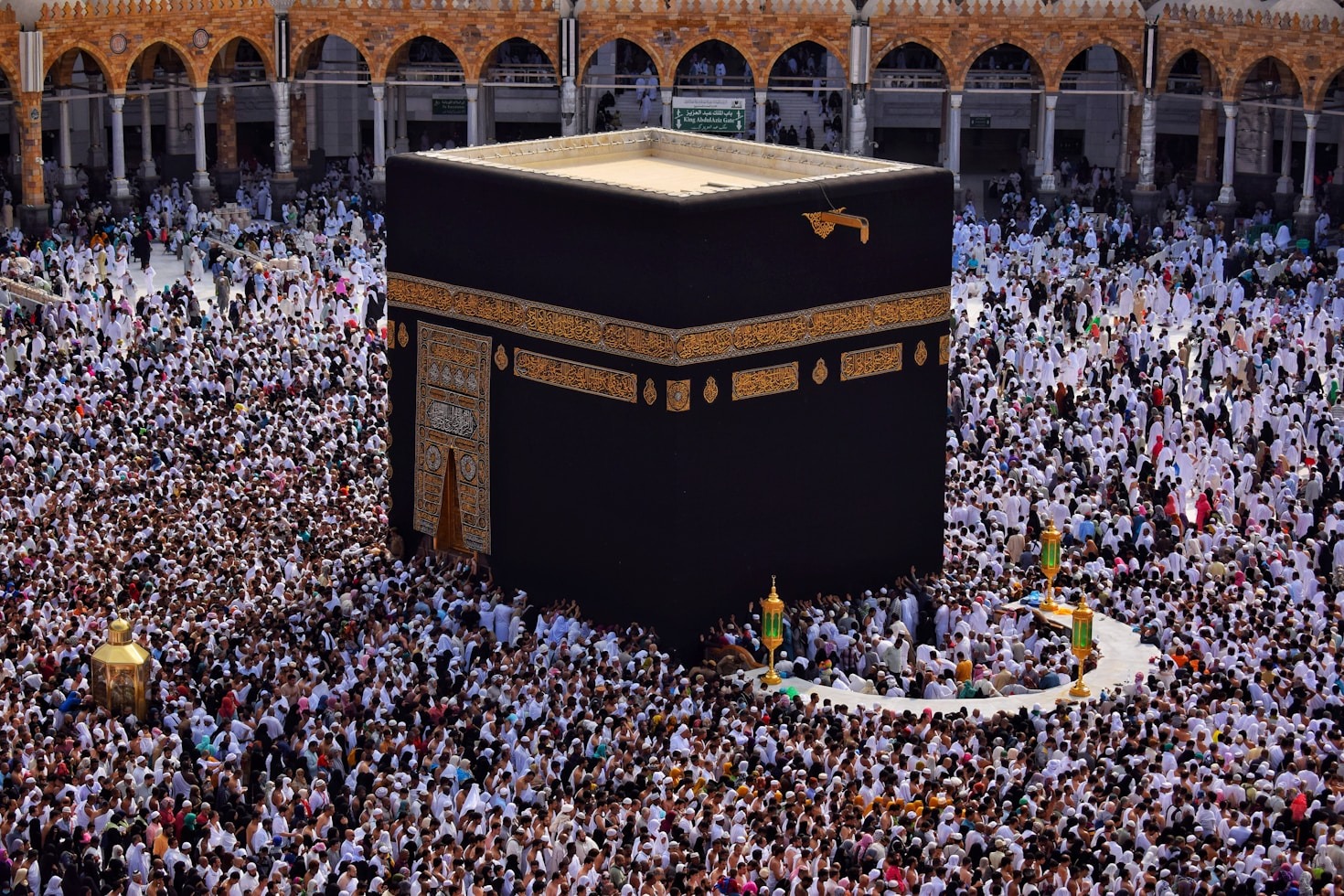Prayer and Pilgrimage
Map of Mecca, Saudi Arabia (NormanEinstein, CC BY-SA 3.0
Map of Mecca, Saudi Arabia (NormanEinstein, CC BY-SA 3.0
The act of pilgrimage to a sacred location is a fundamental tenet across nearly all religions. The Kaaba, which translates to ‘cube’ in Arabic, is a cubic structure, gracefully adorned with a silk and cotton covering. Situated in Mecca, Saudi Arabia, it stands as the most revered shrine in Islam.
In the Islamic faith, adherents are required to pray five times daily, and following the year 624 C.E., these prayers were oriented towards Mecca and the Kaaba instead of Jerusalem; this orientation, known as qibla in Arabic, is indicated in every mosque, guiding the faithful on the direction of their prayers. The Qur’an delineated this prayer direction.
Every Muslim aims to perform the hajj, or the yearly pilgrimage, to the Kaaba at least once in their lifetime, provided they have the means to do so. The practice of praying five times a day and the hajj constitute two of the five pillars of Islam, which are the essential doctrines of the faith.
Upon their arrival in Mecca, pilgrims congregate in the courtyard of the Masjid al-Haram surrounding the Kaaba. They then engage in the act of circumambulation (tawaf in Arabic), walking around the Kaaba, during which they aspire to kiss and touch the Black Stone (al-Hajar al-Aswad), which is set into the eastern corner of the Kaaba.
Eastern corner of the Kaaba featuring the Black Stone (photos: Saudi Arabia General Presidency of the Grand Mosque and the Prophet’s Mosque)
Eastern corner of the Kaaba with the Black Stone, al-Hajar al-Aswad (photos: Saudi Arabia General Presidency of the Grand Mosque and the Prophet’s Mosque)
This paragraph dives deeper into the topic introduced earlier, expanding on the main idea with examples, analysis, or additional context. Use this section to elaborate on specific points, ensuring that each sentence builds on the last to maintain a cohesive flow. You can include data, anecdotes, or expert opinions to reinforce your claims. Keep your language concise but descriptive enough to keep readers engaged. This is where the substance of your article begins to take shape.


The Kaaba’s history and structure
The Kaaba served as a sanctuary during pre-Islamic times. It is believed by Muslims that Abraham, referred to as Ibrahim in Islamic tradition, along with his son Ismail, was responsible for its construction. According to tradition, the original structure was a simple, unroofed rectangle. In approximately 608 C.E., the Quraysh tribe, who governed Mecca, reconstructed the pre-Islamic Kaaba using alternating layers of masonry and wood. To safeguard the shrine from intruders and floodwaters, a door was elevated above ground level.
In 620 C.E., Muhammad was expelled from Mecca to Yathrib, now known as Medina. Upon his return to Mecca in 629/30 C.E., the Kaaba became the central site for Muslim worship and pilgrimage. The pre-Islamic Kaaba contained the Black Stone and idols of pagan deities. Upon his triumphant return to Mecca, Muhammad is said to have purified the Kaaba of these idols, restoring it to the monotheistic faith of Ibrahim. The Black Stone, believed to have been given to Ibrahim by the angel Gabriel, holds great reverence among Muslims. Muhammad undertook his final pilgrimage in 632 C.E., the year of his passing, thereby instituting the pilgrimage rites.
Alterations
Throughout its history, the Kaaba has undergone significant modifications. The second caliph, ‘Umar (634–44), expanded the area surrounding the Kaaba to accommodate the increasing number of pilgrims. Caliph ‘Uthman (644–56) constructed colonnades around the open plaza where the Kaaba is located and integrated other significant monuments into the sanctuary.
The Kaaba adorned with kiswa, circa 1910 (photo: G. Eric or Edith Matson, Library of Congress)
The Kaaba adorned with kiswa, circa 1910 (photo: G. Eric or Edith Matson, Library of Congress)
During the civil conflict between Caliph Abd al-Malik and Ibn Zubayr, who controlled Mecca, the Kaaba was set ablaze in 683 C.E. It is reported that the Black Stone fractured into three pieces, which Ibn Zubayr reassembled using silver. He reconstructed the Kaaba using wood and stone, adhering to the original dimensions set by Ibrahim, and also paved the area surrounding the Kaaba.
Following the restoration of Mecca, Abd al-Malik reinstated the section of the structure believed to have been designed by Muhammad. However, the authenticity of these renovations cannot be substantiated through architectural studies or archaeological findings; they are merely referenced in subsequent literary accounts.
It is reported that during the reign of the Umayyad caliph al-Walid (705–15), the mosque encompassing the Kaaba was adorned with mosaics similar to those found in the Dome of the Rock and the Great Mosque of Damascus. By the seventh century, the Kaaba was draped in kiswa, a black fabric that is replaced each year during the hajj.
Muhyi Lari, illustration of The Great Mosque, Futuh al-Haramayn (a Handbook for Pilgrims to Mecca and Medina), fols 19b–20a, 1582, Mecca, Saudi Arabia (The Khalili Collection)
Muhyi Lari, Illustration of The Great Mosque, Futuh al-Haramayn (a Handbook for Pilgrims to Mecca and Medina), fols 19b–20a, 1582, Mecca, Saudi Arabia (The Khalili Collection)
During the early Abbasid caliphate (750–1250), the mosque surrounding the Kaaba underwent multiple expansions and modifications. Travel writers, including Ibn Jubayr, who visited the Kaaba in 1183, noted that it maintained the Abbasid architectural style from the eighth century for several centuries. From 1269 to 1517, the Mamluks of Egypt governed the Hijaz, the mountainous region in western Arabia where Mecca is situated. Sultan Qaitbay (ruled 1468–96) constructed a madrasa (religious school) adjacent to one side of the mosque. Under the Ottoman sultans, Süleyman I (ruled 1520–66) and Selim II (ruled 1566–74), extensive renovations were carried out on the complex. In 1631, following floods that had devastated the structure the previous year, the Kaaba and the surrounding mosque were completely reconstructed. The mosque that stands today features a vast open area with colonnades on all four sides and seven minarets, the highest number of any mosque globally. At the heart of this expansive plaza lies the Kaaba, along with numerous other sacred buildings and monuments.
The Kaaba, accompanied by its colonnades and minarets, is a pre-Islamic monument that was rededicated by Muhammad in 631–32 C.E. It has undergone multiple renovations and is located in Mecca, Saudi Arabia (photo: marviikad, CC BY-NC 2.0).
The most significant alterations were executed in the 1950s by the Saudi Arabian government to cater to the growing influx of pilgrims participating in the hajj. Currently, the mosque spans nearly forty acres.
The Kaaba today
In its present form, the Kaaba is a cubical edifice, distinct from nearly all other religious structures. It stands fifteen meters tall and measures ten and a half meters on each side, with its corners approximately aligned with the cardinal directions. The entrance to the Kaaba is now constructed of solid gold, a feature that was added in 1982. The kiswa, a large cloth that envelops the Kaaba, which was historically transported from Egypt with the hajj caravan, is now produced in Saudi Arabia. Prior to the development of modern transportation, all pilgrims undertook the often perilous hajj, or pilgrimage, to Mecca in large caravans traversing the desert, departing from cities such as Damascus, Cairo, or other significant urban centers in Arabia, Yemen, or Iraq.
Kiswa of the Kaaba at the golden door, 2016 (photo: Abdullah Shakoor, CC0 1.0)
Kiswa of the Kaaba at the gold door, 2016 (photo: Abdullah Shakoor, CC0 1.0)
The various modifications made to the Kaaba and its surrounding mosque serve as a poignant reminder of the frequency with which buildings, even those of sacred significance, have been renovated and remodeled in response to damage or the evolving needs of the community.
At present, only Muslims are permitted to visit the holy cities of Mecca and Medina.

